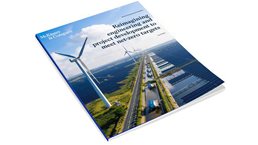Meeting global net-zero targets will require an unprecedented amount of energy. Consequently, an unprecedented number of major projects are required to help facilitate the energy transition. These projects include generating and transmitting more renewable energy, decarbonizing existing facilities, and significantly increasing use of lower-carbon transportation. Although delivering these projects at scale and pace involves significant challenges, doing so will also create a number of exciting opportunities, such as building stronger partnerships with customers; improving the science of construction; deploying integrated engineering, procurement, and construction (EPC); and helping manage risk across and along the supply chain.
To learn more about how infrastructure companies can lead in the transition to net zero, McKinsey’s Tony Hansen spoke with Shaun Kenny, president of Bechtel’s infrastructure global business unit.
Tony Hansen: What industry-wide changes will be required to enable the delivery of the unprecedented number of projects needed to meet net-zero targets, and how is Bechtel responding to these changes?
Shaun Kenny: We’re seeing the G-7 and G-20 commit to a COVID-19 recovery that’s environmentally sustainable and socially inclusive, and this commitment is accelerating secular changes that were already under way. For our industry, the key questions are “what” and “how”—that is, “What types of major projects are being delivered and developed?” and “How will we deliver them?”
If you consider the “what,” we’re seeing many more renewable-generation and transmission projects, more interest in decarbonizing existing facilities, and more low-carbon transport. We’re also seeing more work in digital connectivity and control. It’s one thing to provide more energy, but with better sensor technology and connectivity, energy providers and users can collaborate to save energy. There’s also a great deal of interest in “how” projects are being performed, including an emphasis on designs to reduce materials and improve energy efficiency.
In terms of how Bechtel is responding to the challenge of choosing the right projects and delivering them in the best possible way, there are four key areas we’re focusing on. First, we’re building stronger partnerships with our customers. Second, we’re focusing on the science of construction. Third, we’re looking for opportunities to deploy our EPC mindset and model. Last, we’re helping our supply chain partners manage risk and, in turn, offer more to project teams.
Tony Hansen: Can you give a few highlights where these focus areas are playing out?
Shaun Kenny: On building stronger partnerships with customers, we were the delivery management partner for the tunnels and stations excavation package on the Sydney Metro City & Southwest project. We were able to transfer around 70 percent of that team onto the subsequent Metro West project. In this way, the customer has benefited because we retained the core knowledge, and the distinct working culture and alignment built up a very successful project.
When it comes to the science of construction across the renewables and clean-power sector, our approach to construction focuses on cycle time improvement for the installation of commodities. As an example, we are working on a solar project in Texas with tens of thousands of repetitive installation tasks. The construction schedule is six months, and therefore minutes can easily scale to millions of dollars, so we have implemented our Minutes Matter program, which amplifies incremental improvements to increase productivity and improve repeatability.
Moving on to integrated EPC, we’re now self-performing the civil and marine construction work for our LNG [liquefied natural gas] projects, which we’ve historically used subcontractors for. Today, with the build-out on the US Gulf Coast, we’re vertically integrating these work streams, which delivers much more flexibility and certainty of outcome and has led us to provide continuity of employment for our apprentices and construction professionals through the different project phases.
Finally, when it comes to enabling supply chain partners, we’ve been working on an integrated team with CityFibre, which is investing in schemes across the United Kingdom to train its contractors. We’re bringing our experience to bear in recruitment and training but also helping trade contractors improve their organizational capabilities. In other words, we’re ensuring the team match can operate in this type of environment.

Voices on Infrastructure: Reimagining engineering and project development to meet net-zero targets
Tony Hansen: How will project engineering and project development need to evolve to deliver at the projected scale and pace? Where have you seen breakthrough improvements in project development and engineering that inspire you?
Shaun Kenny: In my experience, when owners are faced with challenges of scale and pace of development, they’re best served by working with EPC contractors from the outset to simplify what is to be built and then eliminating the interfaces that cost money and slow down delivery.
If we look at this through the lens of the natural-gas value chain, upstream, we’ve built more than a third of global LNG production, completing 17 large-scale LNG trains in just five years. The scale of the energy transition is a similar type of challenge to the LNG build-out. It requires close collaboration through project development and the implementation of a fully integrated EPC model that eliminates and optimizes interfaces and is focused on making our construction professionals productive and safe.
Downstream, we’ve installed around eight gigawatts of clean gas power in the United States over the past decade, and we’ve been successful by working with a few customers and select original-equipment manufacturers to develop standard designs and execution plans. This has also allowed us to better understand the talents of the respective teams and, as a result, bring out the best in one another.
Tony Hansen: What needs to change in talent development and retention to mitigate the skill and labor constraints across the value chain?
Shaun Kenny: The highest-performing teams come from inclusive, bias-free, and respectful workplaces where everyone can expect to be treated fairly and have opportunities to progress.
Bechtel is focused on diversity and inclusion. As an example, we’re putting in place programs that are focused on building workplaces that work for women because we still do not see enough women in the industry. We’ve also got our #WeAreBechtel campaign, which is focused on identifying, discussing, and aligning on the behaviors we can expect to see in our workplaces.
Construction jobsites are usually complex environments, so technology that makes it simpler for our construction professionals to stay safe and be more productive is always our goal. For example, our mobile workstations and base camps in the field provide model information to our craft professionals and supervisors to help them visualize what they’re building.
Wherever we’ve been successful, wherever we’ve worked with customers closely and developed successful programs, you’ll see ongoing training and apprenticeship programs and community engagement programs focused on explaining what’s being built and maybe attracting the community into the industry.
Tony Hansen: How will the approaches differ for developing and developed countries?
Shaun Kenny: EPC challenges are universal, but emerging markets offer a greater opportunity to improve the local skills base and to support the long-term growth of the supply chain. Our approach adheres to three dimensions: strong teamwork, continuous training, and smart technology to serve the construction professional.
For example, in the teamwork space, the market in Saudi Arabia today is very strong and talent demand is high, so it’s great to see more women enter the workforce. Changes are happening in the kingdom. It also presents us with an untapped resource we can lean on and reinforces the need to build inclusive workspaces fit for everyone.
One of the things we always focus on is upskilling local communities and providing sustainable skills. Previously, when working in the Middle East on large aluminum projects, we’ve been able to help the project owners develop the supply chain to the emerging downstream industries as well as provide better local options for plant operations and maintenance.
And finally, on the technology side, we use technology to make it simpler for our construction professionals to be safe and more productive. Just as a simple example, we’re using a geographic-information system [GIS] to improve work planning and optimize haul routes on our motorway projects and “as built” utilities to help guide machines to locate and drive piles on our renewables projects.
Tony Hansen: What new partnerships and contracting approaches could improve outcomes?
Shaun Kenny: It’s encouraging to see several transport agencies in the United States engaging private-sector players upstream, earlier, in project planning. We’re seeing these predevelopment agreements [PDAs] trending in passenger rail, as well as with airport authorities and airlines to develop new terminal infrastructure.
The way PDAs work is that the public-sector agencies engage the team that will ultimately implement the project. The team then works with the owner to consider all the technical, commercial, and financial options for the project to arrive at the best solution. This allows the agency to collaborate with the industry practitioners early and come up with a technical solution that not only works but also is financially feasible.
Tony Hansen: What are the competitive-advantage opportunities for first-mover engineering and construction [E&C] companies?
Shaun Kenny: I was at an event recently where Hannah Jones, the CEO of Earthshot Prize, said something that really stuck with me. She made the point that with the challenges the world faces, we should be thinking of the sustainability function as the innovation function.
Until then, I’d always thought of sustainability in the traditional sense, which is more about meeting our needs without compromising the needs of future generations. But I think when you look at it through an innovation lens, it gives sustainability much more urgency. Sustainability is about bringing innovation to the ways we work today to enable the needs of future generations.
Finally, I think that COVID-19 has taught us that we can’t take our frontline workers for granted. For those of us in the integrated EPC world, that means being relentless about safety, building workplaces with a sense of belonging, and serving our frontline construction professionals better. Companies that get this right are going to do the best in the transition to net zero.
This article is part of Global Infrastructure Initiative’s Voices on Infrastructure.
Comments and opinions expressed by interviewees are their own and do not represent or reflect the opinions, policies, or positions of McKinsey & Company or have its endorsement.

